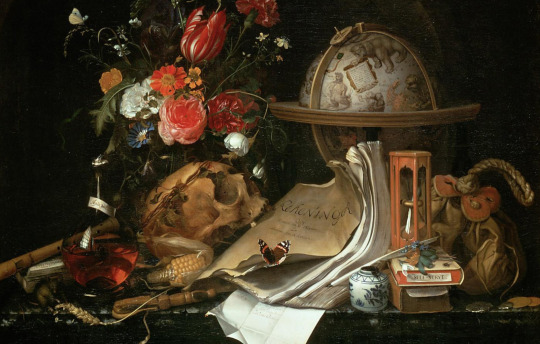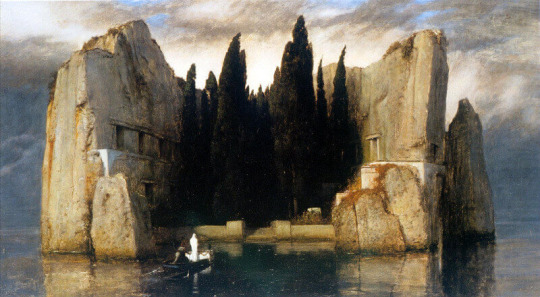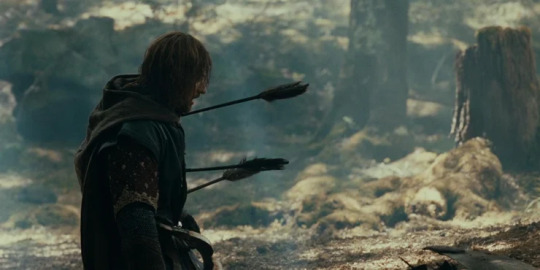#vanitas still life maria van oosterwijck
Explore tagged Tumblr posts
Text
OK SO ASWELL AS THE BALLROOM DRESS BRAINROT IM CURRENTLY OBSESSED W/ PAINTINGS BY MARIA VAN OOSTERWIJCK OH MY FUCK. I KINDA TRIED TO FIGURE OUT THE MEANING BUT I MAY BE HORRIBLY WRONG
WARNING: MENTIONS OF SUICIDE AND SELF HARM, BUT NOT AN IN DEPTH EXPLANATION.

[ID: a painted image of a table with numerous assorted items on it. there is a written note, quill, ink pot and an orange butterfly in the center of the image. beside those items, to the left is a human skull and a vase of pink, white and red roses. there is a yellow flower and a blue flower in the mix. there is also a bottle of an opaque red liquid. on the right side is a globe with people, animals, letters and other miscellaneous items replacing the countries. an hourglass, two books and a bag. there is a half eaten cob of corn and a single peice of wheat. the painting is "vanitas-still life" by maria van oosterwijck. /END ID.]
ok so i think that this all symbolises death. the skull and the bottle of red liquid might be from a human body. not sure. maybe the butterfly species has smth to do w/ death?? maybe the crowded table represents the 7 minutes of memories???? the note might be the letters that were sent, the red liquid symbolising a rough time in life like going through smth that causes self harm?? maybe that was linked to the cause of death??? like. did they die the same way casper (from the other side phone calls) died??? like. did they commit?? idk. the fact that there arent even countries on the globe. there are animals, notes, people and alot of other stuff. maybe that symbolises the "small world" saying. there is also corn which i didnt see!!!!!!!!!!!! not sure what thats abt tho. this is such a pretty painting tho and i love it more than anything. im never going to shut up about it.
3 notes
·
View notes
Text

Vanitas Still-life, Maria van Oosterwijck, 1668
7 notes
·
View notes
Text

Maria van Oosterwijck, Vanitas-Still Life, 1668, Kunsthistorisches Museum, Vienna, Austria
2 notes
·
View notes
Text

Vanitas Still Life, Maria van Oosterwijck
(there is her self-portrait in the bottle reflection)
0 notes
Text
Additional inspiration
After the first photoshoot session and consulting meeting, I've added another main inspiration to the photo series: vanitas/memento mori still life paintings.
vanitas is the sin of pride in Christianity, while memento mori is the idea that everything is temporary and we all going to die one day, what's supposed to humble us.
Like the vaporwave style, vanitas/memento mori still life painting, which are common in western culture since the classical age nd until this very day, reflects an idea that lays between life and death, beauty and decay.

Still-Life with a Skull (1671) by Philippe de Champaigne

Vanitas still life (1668) by Maria van Oosterwijck

Self-portrait With Vanitas Symbols (1651) by David Bailly

Dutch or English School, early 18th century. Still Life of Shrimps in a Porcelain Dish
Symbols I have noticed in still life memento mori paintings:
Candles
Half-eaten food
Flowers, fruits
Clocks, hourglasses
Skulls.
0 notes
Text


Details of Vanitas-Still Life by Maria van Oosterwijck.
#Details of Vanitas-Still Life by Maria van Oosterwijck#Maria van Oosterwijck#Vanitas-Still Life#painter#gothic painting#oil painting#painting#paint#artist#dark art#art#alternative#aesthetic#dark academia#dark academic aesthetic#dark#dark aesthetic#aestheitcs#light acadamia aesthetic#light academia
167 notes
·
View notes
Photo

Maria van Oosterwijck (Dutch, 1630 - 1693): Vanitas still life (1668) (via Kunsthistorisches Museum Wien)
#Maria van Oosterwijck#early women painters#early women artists#dutch painters#vanitas#still life#flowers#women artists#women painters#art#painting#seventeenth century
371 notes
·
View notes
Text




VANITAS STILL LIFE
A vanitas is a symbolic work of art showing the transience of life, the futility of pleasure, and the certainty of death, often contrasting symbols of wealth and symbols of ephemerality and death.
Vanitas by Antonio de Pereda I Vanitas Still-Life with a Bouquet and a Skull, Adriaen van Utrecht, 1642 I Vanitas-Still Life, Maria van Oosterwijck (1630–1693) I Great Vanity, Sebastian Stoskopff, 1641
#darkest academia#dark academia#aesthetic#light academia#academia#moodboard#chaotic academia#art#dark academia aesthetic#quotes#beauty#vanitas#still life#death#dark#dark academia quotes#light academia aesthetic#painting#artists#art academia#classical art#art detail#artwork#paintings#brown#collage#mb#skeletons
290 notes
·
View notes
Photo


1st image by Maria van Oosterwijck(1668)
2nd image by Pieter Claesz(1625)
Notes on Momento Mori
Momento Mori is an art form that translate to, “remember you must die.” It has not only influenced art but philosophy, literature and architecture. The ideology of memento mori is to remind of the invisibility of death and the fragility of life. Epictetus once said :
“do you then ponder how the supreme of human evils, the surest mark of the base and cowardly, is not death, but the fear of death?”
This links to Ernest Becker’s denial of death theory, that the fear of death causes human to do horrible things. The idea of momento mori is to become familiar and comfortable with death, because once you come to terms with it you are liberated. It first originated from Ancient Rome, when a general would win a battle he would be paraded through the streets whilst people cheered, a slave would be behind him however whispering, “rember you must die.” This was to remind the general of his morality, and not to get to big headed.
The ancient Egyptians also took part in remembering death, when feasting they would raise a skull and say,’ drink and be merry, for such shalt thou be when thou dead.”
Buddists practiced Maranasati, which is, “death awareness.”
In some of these examples it seems that momento mori has been used to humble, which is an underlying aim of my film. We believe we are invincible, we believe we are immortal and that has a negative effect on our behaviour as humans I believe, I think its important for the west to be reminded that death comes to us all.
A key art form of Momento Mori is Vanitas, where still life paintings depict carefully placed objects that symbolise the fleeing nature of life, and how we should not waste our time on meaningless objects and pleasures; the two images above are examples of these paintings. Common objects in these paintings are, “skulls, candles, hourglasses, watches, rotting fruit, wilting flowers and fraying books.” Symbolically placing objects next to a skull serves as a reminder of the impermanence of us and our objects, the dying flowers and Burnt out candles also depict this. Clocks and hourglass are used to show time running out, and bubbles are sometimes placed to again show fragility of life.
Momento mori was also heavily popular in the victorian times, they wee fascinated with death, they would spend years meticulously planning their last words, they would even take photographs with their deceased ones. Momento mori jewellery was very popular during this time, they would wear rings with skeletons, sometimes wearing crowns to show deaths superiority.
5 notes
·
View notes
Text

Vanitas Still Life - Maria van Oosterwijck (1668)
5 notes
·
View notes
Photo

Maria van Oosterwijck, Vanitas Still Life, 1668
10 notes
·
View notes
Photo

Vanitas-Still Life by Maria van Oosterwijck
133 notes
·
View notes
Photo

Vanitas Still Life (1668) - Maria van Oosterwijck
“calculation – we live unto death and die unto life”
0 notes
Text
0 notes
Text
Gestaltningsarbete - del 4
Vad är död egentligen?
Ett slut. Något som slutar att existera i den form det har funnits tidigare. Det är en för��ndring. Ett slut är inte alltid dåligt. Det kan ge föda till något nytt. Ett avslut för något kan vara en start och nyfödelse. I naturen innebär döden nytta för andra t ex avkomman som blev beskyddade av den omkomna, eller föda för andra varelser. Växter gror från de förlegade och avlidna för att skapa mer liv och en fortsättning.
Vi kan aldrig veta hur andra djur ser på död och att förlora någon nära, men jag anar att det är liknande som vi känner. En sorg och saknad över att det som vi hade har upphört.
Genom tiderna har människor försökt att finna sätt att förhålla sig till döden. Vi minns nog alla den dagen när vi själva fick förståelse för vad döden innebar, där vi förstod att ja, det är ett avslut. Jag fick detta ögonblick i Tingstadstunneln när min pappa berättade att min mamma kanske inte skulle överleva en operation hon gjorde. När jag fick se min mamma på sjukhuset, där hennes ben trängde fram, likt ett skelett insåg jag att det värsta kunde ske. Tack och lov överlevde hon detta.

“Vanitas Still-Life.” 1668. Maria van Oosterwijck.
Min farmor begick självmord när jag var tio år. Jag fick berättat för mig att hon var död. Vad det betydde var svårt att förstå men jag fick inte träffa henne igen. Jag fick aldrig mer besöka hennes lägenhet. Det var ett plötsligt slut på ett skede i hennes liv och vi andras.
Men jag tror att det tillfället där jag verkligen förstod var det innebar vad när jag såg en man lägga sig på spåren framför ett tåg. Tåget hade ingen chans att stanna, och detta visste mannen. Bara en hundra meter eller så innan tåget körde förbi, tog sig mannen förbi bommen och stod framför tåget. Jag trodde först att det var en pojke som ville göra ett skämt men när han lade sig ner... då förstod jag att han inte skämtade.
Det är inte många som kan säga att de inte fruktar döden. Jag har knappt träffat någon med det tankesättet, speciellt inte yngre människor. Min morfar var underbar när han diskuterade hur det kändes att få en hjärtattack. Han sa, “Jaha, ja då var det min tur. Jag är okej med det... men att det skulle göra ont var ju inte så kul.” Jag tänkte på detta år senare när han faktiskt somnade in. Han blev 92 år. Han hade ingen ånger eller ångest över att dö. Han var nöjd att han hade fått leva. Han såg det som ett nytt steg. Jag hoppas innerligt att jag får uppnå den sinnesron. ________________________________________________________________ Kulturer och grupper av människor försöker och har försökt att förstå sig på döden. Det finns oerhörd mystik i det och människor söker sätt att förstå sig på saker. Vi vill lära oss. Men döden verkar inte som att vi helt har förstått oss på som samhälle.
Genom tiderna har olika bilder kring döden och sorg funnits. Grekerna hade Hades. Vikingarna Valhalla. Kristendomen har Jesus... myter om spöken och efterlivet har funnits och det är berättelser vi berättar vidare och vidare.

“The Isle of the Dead”. 1883. Arnold Böcklin. En mytologisk berättelse med inspiration av verkliga livet skapade denna fantastiska målning och berättelse.
________________________________________________________________
Berättelser får en helt ny mening när man introducerar aspekten av död och tragedin som finns i det. Det blir mer spännande när det finns enorma konsekvenser till saker. Min partner, Ian, han är skådespelare och han har många gånger sagt till mig att “en skådespelares jobb är att ge folk hopp”. Jag skulle vilja påstå att det är detsamma med all typ av kreativt skapande. Skrivande, målande, filmskapande, fotografier... skapare, bra skapare, använder sina egna osäkerheter och rädslor i berättelser på ett eller annat sätt. De skapar något som känns “äkta”.
Jag minns Sagan om Ringen, när jag var tolv år och såg filmen på bio. Jag blev chockad, förtvivlad och konstigt nog “frestad” av scenen där Boromir dör (SPOILER). Jag grät långt efter filmen var slut och än idag är den scenen så oerhört viktig och stark i mitt liv. När jag menar frestad.. hur ska jag förklara det? Det är något spännande och läskigt med det. Självklart är det fruktansvärt och jobbigt men på något sätt när man inte själv utsätts för det eller ens närstående så är det abstrakt på ett sätt jag inte kan förklara.

The Lord of the Rings: The Fellowship of the Ring. 2001. J.R.R. Tolkien, Fran Walsh. Peter Jackson (Regi). New Line Cinema.
Författaren J.R.R. Tolkien var en överlevare från första världskriget där han mötte fruktansvärda ögonblick. Alla som har läst eller sett SOR vet hur fruktansvärt läskig plats “the Dead Marshes” är. Här kommer ett kort citat från New York Times, “How J.R.R. Tolkien Found Mordor on the Western Front” (2016) https://www.nytimes.com/2016/07/03/opinion/sunday/how-jrr-tolkien-found-mordor-on-the-western-front.html
“On the path to Mordor, stronghold of Sauron, the Dark Lord, the air is “filled with a bitter reek that caught their breath and parched their mouths.” Tolkien later acknowledged that the Dead Marshes, with their pools of muck and floating corpses, “owe something to Northern France after the Battle of the Somme.”
Som jag har skrivit om tidigare är skapande ett sätt att bearbeta, hantera och se saker som är svåra i vår vardag med nya ögon. Genom berättelser, myter och traditioner försöker människor att förstå sig på döden, avslutet. Jag tror att många som jag har fått tanken att man måste lämna efter sig något så att man kan leva till och med efter döden. Tyvärr gör de flesta inte det. Det finns för många människor som har levt, lever och kommer att leva, för oss att följa. Vi har en tid där vi får vandra och existera. De flesta kommer fram till att vi måste göra det bästa vi kan för att uppskatta varje minut. Men det är inte så lätt. Speciellt inte om man är elev eller student.
Nu har jag skrivit ett bra tag... men jag har inte beslutat mig för något nytt i gestaltningen verkar det som. Jag fick ett par idéer där jag har en bild på en kvinna som står över sin egna kropp och har på något sätt lagt undan eller dödat hennes förflutna alternativt ändrat sin personlighet. Är inte det en sorts död? T ex när man lämnar barndomen bakom sig? Så allt tror jag inte behöver handla om just döden utan det kan även vara efter döden, de som lämnas, de som lever... :)
0 notes